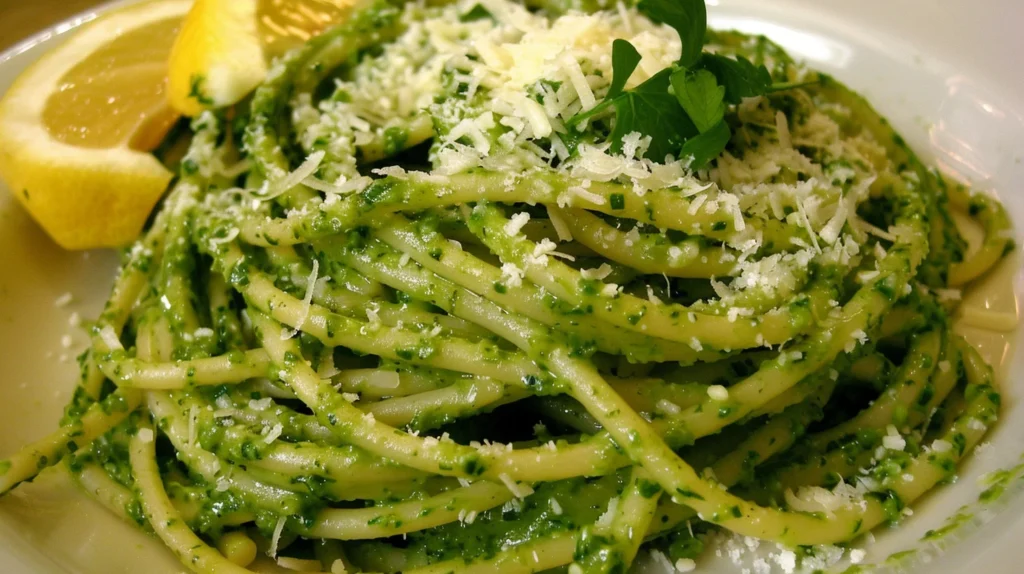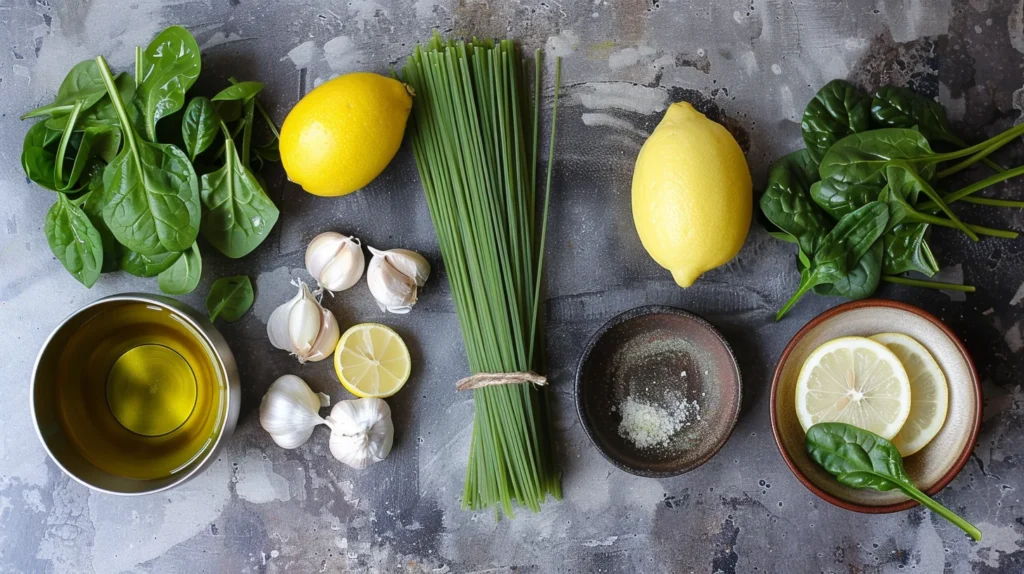
| Serving Size | Calories per Serving | Total Fat | Carbs | Protein |
|---|---|---|---|---|
| 1 Cup (Approx. 200g) | 350-400 kcal | 12g | 50g | 10g |
| 1 Plate (Approx. 300g) | 500-600 kcal | 18g | 75g | 15g |
| Low-Calorie Version (Zucchini Noodles) | 200-250 kcal | 8g | 25g | 8g |
Let’s be real—pasta lovers are always looking for new ways to enjoy their favorite comfort food without the guilt. Enter green spaghetti, a vibrant twist on traditional pasta that’s not only delicious but also healthier (or so they say). But here’s the burning question: How Much Calories Are in Green Spaghetti? Is it really better for you, or is it just another food trend wrapped in a pretty green bow? 🤔
Let’s dig in and find out everything you need to know about the calories in green spaghetti, including how it stacks up nutritionally, how to make healthier versions, and even some common mistakes to avoid.
What Is Green Spaghetti? A Brief Introduction
Green spaghetti might sound a little odd at first. I mean, green? Really? But trust me, once you’ve tried it, you’ll be hooked! So, what exactly is it? Green spaghetti is a pasta dish typically made with a creamy green sauce, often using ingredients like spinach, basil, cilantro, or even avocado. Think of it as pasta that’s gone green for good reasons—kind of like your favorite superhero going green to save the planet. 🌱
There are plenty of variations, from Mexican-style green spaghetti with poblano peppers to Italian pesto versions. No matter which version you try, one thing’s for sure: it’s tasty, versatile, and visually appealing.
History and Origins of Green Spaghetti
Where did green spaghetti come from? Well, like many great dishes, it has roots in several cultures. The Mexican version features a creamy poblano sauce that pairs beautifully with spaghetti. In contrast, the Italian variation leans more on pesto made from basil, garlic, and olive oil. Both versions are delicious, but they differ slightly in calorie count, which we’ll cover soon.
Types of Green Spaghetti Recipes
There’s no one-size-fits-all when it comes to green spaghetti. Here are some popular variations you can try:
- Spinach and Cream Sauce – A rich, creamy sauce made with blended spinach and cream.
- Pesto Green Spaghetti – Classic Italian flavors with basil, garlic, and pine nuts.
- Avocado Green Spaghetti – A vegan-friendly option with creamy avocado sauce.
- Mexican Green Spaghetti – Spicy and savory with poblano peppers.
No matter which one you choose, they’re all packed with flavor. But what about the calories? Let’s move on to the nutritional breakdown.
Table of Contents
Nutritional Value of Green Spaghetti
Here’s where things get serious. If you’re watching your calorie intake, you’ll want to know exactly what you’re getting when you sit down to a plate of green spaghetti.
Calorie Content in Green Spaghetti per Serving
The calorie content of green spaghetti depends on a few factors: the type of sauce, the ingredients, and the portion size. On average, a serving of homemade green spaghetti ranges between 300-500 calories. However, if you’re adding heavy cream or cheese, those numbers can quickly climb.
💡 Pro Tip: Want to cut calories? Swap out the heavy cream for Greek yogurt or use almond milk instead!
Macronutrients Breakdown: Carbohydrates, Proteins, and Fats
Let’s break down a typical serving of green spaghetti (about 1 cup):
- Calories: 350 (average)
- Carbohydrates: 50g
- Proteins: 12g
- Fats: 10g
It’s worth noting that most of the calories come from the pasta itself, not the sauce. So, if you’re really looking to make a difference, you might want to choose whole wheat or low-carb pasta options.
Vitamins and Minerals Found in Green Spaghetti
What makes green spaghetti a bit healthier than regular spaghetti? The greens, of course! Depending on the recipe, you’ll get a good dose of:
- Vitamin A (great for your eyes 👀)
- Vitamin C (boosts your immune system)
- Iron (helps fight fatigue)
- Calcium (strengthens bones)
“Eating green spaghetti is like giving your body a little plant-based hug. It’s comfort food with benefits!”
How to Calculate Calories in Homemade Green Spaghetti
If you’re making green spaghetti at home, you’re in control. This means you can make it as healthy (or indulgent) as you want. Here’s a quick guide to calculating the calories in your dish.
Ingredients That Affect Calorie Count
The key to understanding your calorie intake is knowing what goes into your green spaghetti. Here are some common ingredients and their approximate calorie counts per serving:
- Pasta (regular): ~200 calories per cup
- Spinach: ~7 calories per cup
- Basil: ~1 calorie per tablespoon
- Pesto Sauce: ~240 calories per 1/4 cup
- Heavy Cream: ~50 calories per tablespoon
- Cheese (Parmesan): ~110 calories per ounce

Serving Size and Calorie Variations
Portion control is key. A small portion of green spaghetti can be relatively low in calories, but let’s be honest—who eats just a small portion of pasta? If you’re piling your plate high, you’re probably consuming more calories than you think.
Calorie Comparison with Other Pasta Dishes
How does green spaghetti compare to other pasta dishes?
| Dish | Calories per Serving |
|---|---|
| Regular Spaghetti | 310 |
| Alfredo Pasta | 600 |
| Green Spaghetti | 350 (average) |
| Pesto Pasta | 400 |
As you can see, green spaghetti falls somewhere in the middle. It’s healthier than Alfredo but slightly higher than plain spaghetti.
“Think of calories like money. You want to spend them wisely, right? Green spaghetti is like buying something that’s both practical and stylish—it looks good and feels good!”
Health Benefits of Eating Green Spaghetti
Sure, calories are important, but food isn’t just about numbers. It’s about nourishing your body and enjoying what you eat. The beauty of green spaghetti is that it offers more than just a delicious meal—it also packs some serious health benefits. Let’s take a closer look at why you might want to swap your regular pasta for this vibrant, nutrient-packed alternative.
Why Green Spaghetti Can Be a Healthier Option
Green spaghetti isn’t just Instagram-worthy; it’s genuinely healthier. The green sauce typically contains leafy greens like spinach, basil, or cilantro, which are loaded with nutrients.
Here’s why it’s a win for your health:
- Rich in antioxidants: The greens in the sauce help your body fight free radicals, reducing the risk of chronic diseases.
- High in fiber: If you choose whole wheat pasta or add vegetables to your dish, you’ll get a healthy dose of fiber, which is great for digestion.
- Good source of plant-based iron: Many green sauces contain spinach, a plant-based source of iron that helps with energy levels.
- Supports heart health: Ingredients like olive oil, nuts, and garlic (common in green sauces) are known to promote heart health.
So, it’s not just about the calories. Green spaghetti nourishes your body in ways regular pasta can’t. 💚
Impact on Weight Loss and Diet Plans
Thinking of losing weight? Green spaghetti can be part of your meal plan—if you play your cards right.
Here’s how to make it weight-loss friendly:
- Choose whole wheat or low-carb pasta: These options have more fiber and fewer carbs than traditional pasta.
- Go easy on the sauce: While the sauce is where the magic happens, it can also pack a calorie punch. Try using Greek yogurt or avocado as a base instead of heavy cream.
- Add protein: Toss in some grilled chicken, shrimp, or tofu to make your meal more filling without adding too many calories.
💡 Did you know? Green spaghetti with a spinach-based sauce can have fewer calories than traditional Alfredo pasta by up to 50%!
Tips to Make a Low-Calorie Green Spaghetti
Looking to keep things light? Here are some tips to make low-calorie green spaghetti without sacrificing flavor:
1. Swap Pasta for Veggie Noodles
Instead of traditional pasta, try:
- Zucchini noodles (zoodles)
- Spaghetti squash
- Shirataki noodles
These alternatives are low in calories and high in fiber, making them perfect for weight loss.
2. Choose a Light Sauce Base
Heavy cream is delicious but loaded with calories. Try these healthier alternatives:
- Greek yogurt (creamy but low in calories)
- Avocado (adds a rich texture without the guilt)
- Cashew cream (a vegan option that’s also healthy)
3. Load Up on Veggies
Add more spinach, broccoli, zucchini, or peas to your green spaghetti. Not only will this boost the nutritional value, but it will also make the dish more filling without adding tons of calories.
Popular Variations of Green Spaghetti and Their Calorie Counts
Let’s talk about the different variations of green spaghetti and how many calories they pack.
Green Spaghetti with Spinach Sauce
This is the classic version. The sauce is made by blending spinach, garlic, olive oil, and Parmesan cheese.
- Calories per serving: ~350
Green Spaghetti with Pesto
Pesto-based green spaghetti is packed with basil, garlic, pine nuts, and olive oil.
- Calories per serving: ~400-450
Vegan and Gluten-Free Green Spaghetti Options
For those with dietary restrictions, there are plenty of vegan and gluten-free options.
Here’s a quick breakdown:
- Vegan green spaghetti: Made with avocado or cashew-based sauces (~300-350 calories)
- Gluten-free pasta: Use pasta made from quinoa, lentils, or rice flour
Calories in Store-Bought Green Spaghetti vs. Homemade
Homemade green spaghetti allows you to control the calorie content by swapping out high-calorie ingredients for healthier alternatives. Store-bought versions, on the other hand, might contain preservatives and higher fat content.
Looking to make more homemade meals? Check out this Galena Chicken Recipe for a flavorful, easy-to-prepare dish that’s perfect for any occasion.
Wondering whether it’s better to make green spaghetti at home or grab a ready-made version from the store? Here’s the scoop.
| Type | Calories per Serving | Pros | Cons |
|---|---|---|---|
| Homemade Green Spaghetti | ~350 | You control the ingredients | Takes time to prepare |
| Store-Bought Green Spaghetti | ~400-500 | Quick and convenient | Higher in preservatives |
“Think of homemade green spaghetti as a canvas—you get to decide what goes on it. Store-bought? It’s like buying someone else’s artwork—it might look good, but you didn’t have any say in it!”
Frequently Asked Questions (FAQs)
1. How Many Calories Are in One Cup of Green Spaghetti?
The exact calorie count for one cup of green spaghetti depends on the ingredients and how it’s prepared. However, on average:
– Homemade green spaghetti: ~300-400 calories per cup
– Store-bought versions: ~400-500 calories per cup
If you want to cut calories, reduce the amount of cheese and heavy cream in your sauce. Opt for lighter ingredients like Greek yogurt or vegetable-based sauces.
2. Is Green Spaghetti Good for Weight Loss?
Absolutely! But like with any dish, it depends on how you prepare it. Here are some tips to make weight-loss-friendly green spaghetti:
– Swap regular pasta for zoodles (zucchini noodles) or whole wheat pasta.
– Use a lighter sauce made with spinach, avocado, or Greek yogurt.
– Portion control is key—don’t overindulge!
Think of it this way: Green spaghetti can be a part of your weight-loss journey if you make smart ingredient swaps.
3. Can I Eat Green Spaghetti on a Low-Carb Diet?
Yes, but with some modifications! Traditional pasta is high in carbs, but you can easily make a low-carb version of green spaghetti by using alternatives like:
– Zucchini noodles (zoodles)
– Spaghetti squash
– Shirataki noodles
You’ll still get all the flavor and nutrients without the extra carbs.
4. What Is the Healthiest Way to Prepare Green Spaghetti?
If you’re looking to make the healthiest version of green spaghetti, here’s what you can do:
1 – Use whole wheat pasta or veggie noodles for added fiber.
2 – Go for a sauce made with spinach, avocado, or Greek yogurt.
3 – Add protein like grilled chicken, shrimp, or tofu to make the meal more balanced.
4 – Cut back on cheese and oil to reduce calories and fat.
5. Is Green Spaghetti Vegan-Friendly?
Yes, if you choose lighter ingredients like zoodles or whole wheat pasta. Check out this Chickpea Flaxseed Salad Recipe for a high-fiber, low-calorie alternative.
It can be! Many green spaghetti recipes are easily adaptable for vegan diets. Here’s how:
- Use plant-based milk (like almond or oat milk) instead of heavy cream.
- Replace Parmesan cheese with nutritional yeast or vegan cheese.
- Make the sauce with avocado or cashew cream for a creamy texture.
Calories Comparison: Green Spaghetti vs. Other Popular Pasta Dishes
Let’s see how green spaghetti stacks up against other popular pasta dishes:
| Dish | Calories per Serving | Healthiness Score (1-10) |
|---|---|---|
| Regular Spaghetti | ~310 | 6 |
| Alfredo Pasta | ~600 | 4 |
| Pesto Pasta | ~450 | 7 |
| Green Spaghetti | ~350 | 8 |
| Vegan Green Spaghetti | ~300 | 9 |
As you can see, green spaghetti comes out on top as a healthier option compared to many traditional pasta dishes.
Conclusion: Final Thoughts on Green Spaghetti Calories and Nutrition
So, what’s the verdict? Green spaghetti is a win if you’re looking for a delicious, healthier alternative to regular pasta. It’s packed with nutrients, can be made low in calories, and is versatile enough to fit any dietary preference.
Here’s why you should add green spaghetti to your menu:
- It’s a healthier option compared to many other pasta dishes.
- You can control the calorie count by choosing the right ingredients.
- It’s versatile and customizable—perfect for vegan, low-carb, or weight-loss diets.
“Green spaghetti isn’t just a meal; it’s a lifestyle upgrade. Think of it as pasta with a purpose—delicious, healthy, and guilt-free!”
Key Takeaways:
- On average, green spaghetti has 300-400 calories per serving.
- You can make it healthier by swapping out high-calorie ingredients like heavy cream for lighter options.
- Portion control and smart ingredient choices make all the difference.
A Quick Recipe for Low-Calorie Green Spaghetti
Here’s a simple recipe to make a low-calorie green spaghetti at home:
Ingredients:
- 1 cup whole wheat or zucchini noodles
- 1 cup spinach (blanched)
- 1 clove garlic
- 1 tbsp olive oil
- 2 tbsp Greek yogurt
- Salt and pepper to taste
- Lemon juice for freshness

Instructions:
- Cook the noodles as per the package instructions.
- In a blender, combine spinach, garlic, olive oil, Greek yogurt, salt, and pepper. Blend until smooth.
- Toss the sauce with the noodles.
- Squeeze a bit of lemon juice on top and enjoy!
